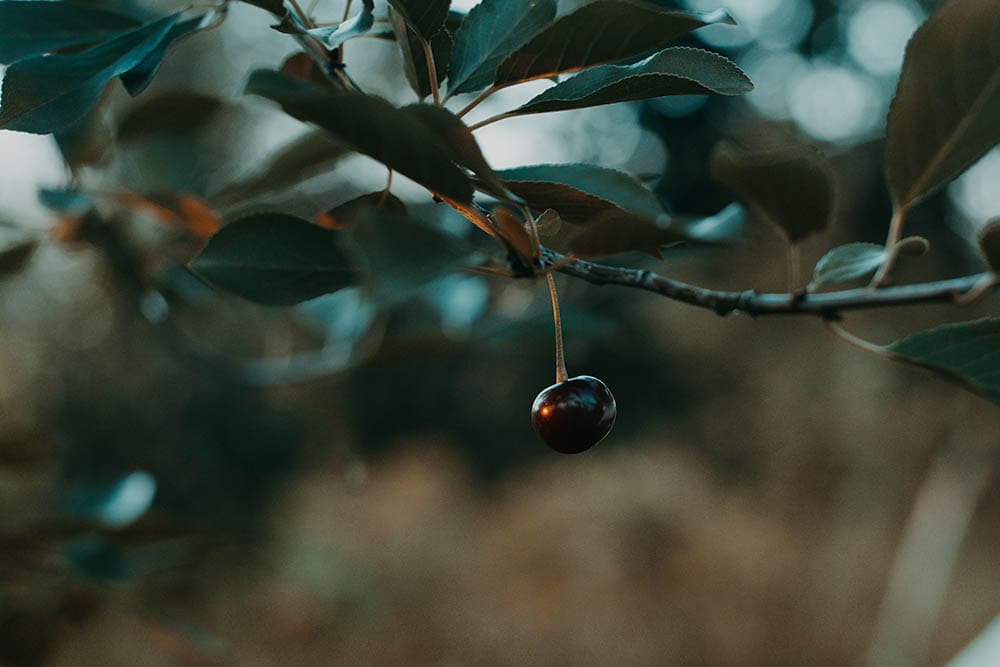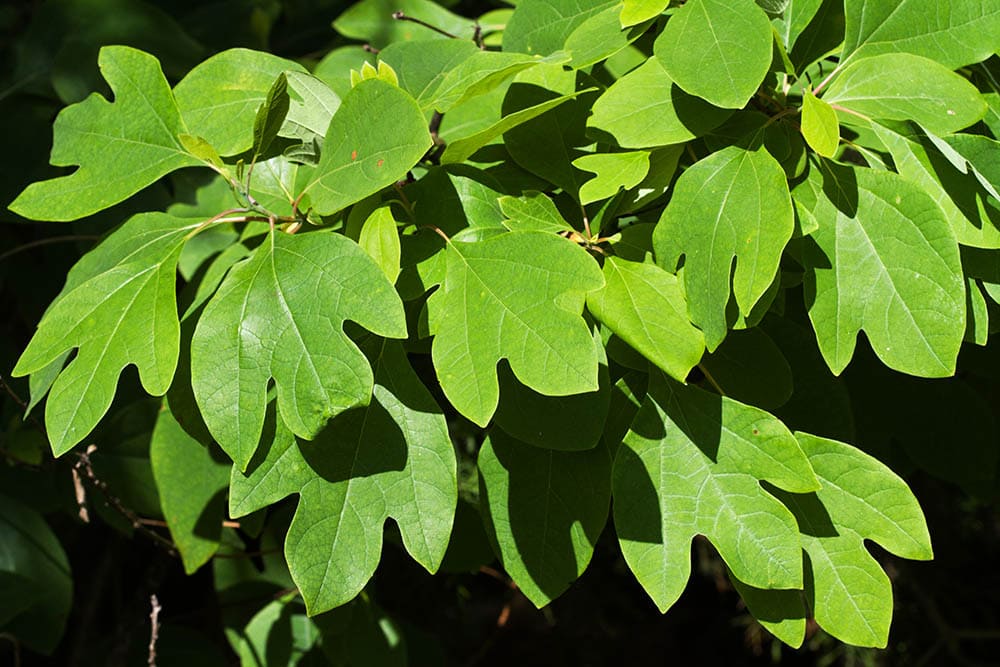13 Types of Trees in Maryland (With Pictures)
-

- Last updated:

Maryland has the nickname “America in Miniature” for its diverse population, historic towns and cities, and an abundance of wildlife and plants. Due to the temperate climate, Maryland has quite a few types of trees. If you are a Maryland resident or plan on visiting this little state, spend some time outdoors and check out the forests.
Here is a list of the 13 most common trees you will find when going on hikes in Maryland. The list is divided by the common deciduous trees and evergreen trees.

The 13 Types of Trees in Maryland
Common Deciduous Trees of Maryland
1. Red Maple (Acer rubrum)

| Height | 60–90 feet |
| Average Lifespan | 60 to 90 years |
| Sun Exposure | Full sun, partial shade |
The red maple is one of the most common maples native to Maryland. This species of maple got its name from not only the color the leaves turn in autumn, but also because of the vibrant red color of the flowers and fruits. Reaching between 60–90 feet at full maturity, the red maple thrives best in full sunlight and moderate watering. However, it is also known to tolerate shade.
This tree is essential for Maryland wildlife, such as rabbits, deer, chipmunks, and squirrels, as they use the tree for food and shelter.
2. White Hickory (Carya tomentosa)
| Height | 50–80 feet |
| Average Lifespan | up to 500 years |
| Sun Exposure | Full sun, partial shade |
The white hickory is another common tree you can easily find in Maryland. This outstanding tree can live for several hundred years, producing hickory nuts for 200 years after reaching maturity. However, you will need to have some patience with the white hickory tree; it will take up to 25 years before it starts producing nuts. In addition to using the tree for nuts, it can also be used for firewood and furniture.
3. American Beech (Fagus grandifolia)

| Height | 50–70 feet |
| Average Lifespan | over 300 years |
| Sun Exposure | Full sun |
The American beech tree is most easily recognizable by its silver-colored bark and was widely used among early settlers immigrating to the United States. While people do not use the American beech leaves to fill mattresses or the ash to make lye soap, this tree is still used for high-quality flooring and furniture. This tree also produces beechnuts, which are an important food source for an abundance of wild animals, such as deer, chipmunks, squirrels, and even black bears.
4. White Ash (Fraxinus americana)

| Height | 60–80 feet |
| Average Lifespan | 260–300 years |
| Sun Exposure | Full sun |
The magnificent white ash tree is probably best known for its autumn foliage. The leaves turn a deep reddish purple and vibrant orange that can be seen from long distances. Despite the tree’s lush foliage, deer do not seem to seek the mature trees out for sustenance. Besides being a lovely tree to gaze upon, the white ash is used to make sporting equipment. Due to its tough and sturdy wood, the white ash is used to make baseball bats, hockey sticks, and tennis racquets.
5. Yellow Poplar (Liriodendron tulipifera)

| Height | 90–130 feet |
| Average Lifespan | 100–200 years, up to 300 years in ideal conditions |
| Sun Exposure | Full sun, partial shade |
The tall yellow poplar, also known as the tulip poplar, is a sight to see because of its beautiful tulip-like flowers that bloom during the spring. These flowers attract a plethora of Maryland wildlife, from hummingbirds to white-tailed deer. However, the tree will not begin producing flowers until it is around 15–20 years of age. The yellow poplar is also used as general lumber; although it is considered a weaker wood, it is still used for some furniture, veneer, and paper pulp.
6. Black Cherry (Prunus serotina)

| Height | up to 125 feet |
| Average Lifespan | up to 100 years |
| Sun Exposure | Partial shade, shade |
The black cherry tree can be easily identified by looking at the bark. People often describe the black cherry tree’s bark as burned cornflakes. Of course, when the white flowers of the tree turn to fruit, you can see the dark reddish-purple cherries. Not only are these cherries a tasty treat for humans, but they are also a vital part of the diets of Maryland’s birds and mammals. The black cherry tree’s wood is also a valuable material for making furniture and toys because of its reddish color.
7. White Oak (Quercus alba)

| Height | 60–100 feet |
| Average Lifespan | 500–600 years |
| Sun Exposure | Full sun, partial shade, shade |
The white oak has earned its place as Maryland’s state tree and for good reason. This extremely slow-growing tree can live for centuries, adorning wherever they grow with deep green leaves in the summer and bronze in the autumn. White oaks produce acorns that have a less bitter taste than other oaks found across the state. These acorns are a major food source for squirrels, chipmunks, rabbits, turkeys, and deer. The wood of the white oak is extremely valuable because it is water- and rot-resistant, making it ideal for boats and whiskey or wine barrels.
8. Sassafras (Sassafras albidum)

| Height | 30–60 feet |
| Average Lifespan | Up to 100 years |
| Sun Exposure | Full sun, partial shade |
The fast-growing sassafras tree got its claim to fame because of its roots, which were a key ingredient in root beer. While most root beers are flavored with artificial sassafras flavoring, the tree is beneficial for the Maryland landscape because of its wonderful aroma. Many people say the bark smells of cinnamon and the leaves like lemon. In addition to the tree’s scent, the leaves become brightly colored in autumn. These trees grow well in full sun or partial shade, making it an easy tree to add to a park or yard.
Common Evergreen Trees of Maryland
9. American Holly (Ilex opaca)

| Height | 40–50 feet |
| Average Lifespan | Up to 100 years |
| Sun Exposure | Full sun, partial shade |
The American holly, also known as the Christmas holly, is an evergreen tree with dark green leaves with sharp pointed edges. The female trees produce bright red berries that last through the winter. The combination of the dark green and bright red colors of the American holly tree during the winter months provides a holiday-feel. While the berries are a food source for small mammals, humans should not consume them as they are toxic to people. This is a slow-growing tree but can last for up to 100 years in the right conditions, like well-drained soil and full or partial sunlight.
10. Eastern Red Cedar (Juniperus virginiana)

| Height | 30–40 feet, up to 90 feet in certain conditions |
| Average Lifespan | Up to 500 years |
| Sun Exposure | Full sun, partial shade, shade |
The Eastern red cedar is another tree many Marylanders associate with the holiday season. When trimmed, it looks like a large Christmas tree! The pine needles make this tree aromatic and a festive addition to your yard. The wood from this tree has been used for furniture and sought after by the early colonists for building log cabins. While it might not be used as much for housing today, the Eastern red cedar serves as shelter for small mammals and birds.
11. Sweetbay Magnolia (Magnolia virginiana)

| Height | 15–20 feet |
| Average Lifespan | 130 years |
| Sun Exposure | Full sun |
The sweetbay magnolia is a tree with threatened status because the swamps and wetlands where they thrive are becoming vulnerable. This is unfortunate because the sweetbay magnolia produces some gorgeous white flowers during the late spring to early summer. Because of the flowers and shiny, deep green leaves, this tree is more ornamental. The leaves do have some medicinal uses, but mostly the tree is used to add beauty and variety to a yard or park.
12. Eastern White Pine (Pinus strobus)

| Height | 50–80 feet |
| Average Lifespan | 200 years, may even get to 450 years |
| Sun Exposure | Full sun, partial shade |
While Maryland is home to many pine trees, the Eastern white pine tree is one of the most common. Why? It is often used as Christmas trees for the holiday season. This fast-growing pine tree prefers long hours of direct sunlight, but it will still thrive with at least 4 hours of sunlight each day. The pine seeds of this tree are food for many animals, such as black bears, deer, rabbits, and birds.
13. Northern White Cedar (Thuja occidentalis)

| Height | 40–70 feet |
| Average Lifespan | 400 years |
| Sun Exposure | Partial shade, shade |
Another common evergreen tree is the Northern white cedar tree. This tree prefers swampy areas of Maryland, easily surviving in poorly draining soil. You will be able to find this tree more commonly around lakes, bogs, and streams in addition to swampy areas. When this tree reaches maturity, it produces egg-shaped pine cones in abundance. The Northern white cedar tree has plenty of uses, such as fencing, log cabins, boat making, and ornamental uses.
Final Thoughts
Maryland is a state full of outstanding natural surroundings. Now that you are familiar with the common trees of Maryland, you can easily identify them on hikes or other outdoor excursions. Understanding nature gives us a better awareness that the environment across the United States should be respected and protected.
Featured Image Credit: Kevan Craft, Pixabay
Contents

